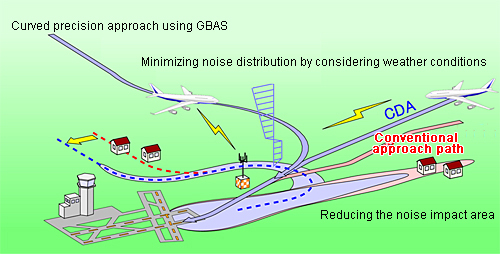Research & Development
JAXA promotes three research and development programs and a fundamental research program that underpins them.
Noise abatement technology
- September 25, 2014
- Noise measurements taken around Narita Airport
Expected future increase in air traffic is also going to cause increase in the noise pollution in airports' vicinity. An estimate shows that traffic volume in airports' airspace in the year 2027 will become 1.5 times that in 2005, which in turn will increase the ground noise level as well.
As a part of the DREAMS project, JAXA has researched and developed the "low noise operation technology", which determines an approach path that can reduce noise by predicting noise diffusion according to the influence of weather, and which directs the path of an aircraft, so that the noise range might remain within the present state even in the view of 50% traffic increase.

Concept of noise abatement technology
Noise prediction models
Weather conditions such as wind, temperature, and humidity can affect the way noise travels. Accurate prediction of weather effects on noise propagation is important to derive an optimum flight path to mitigate noise.
Furthermore, high-speed computations are also required in order to cope with increasing air traffic. JAXA has developed the noise prediction models and validated them by measuring simulated noise sources emitted from a balloon-hung loudspeaker towards the ground.
Low-noise path optimization
Ground based augmentation systems (GBAS) are being introduced into airports to improve the precision of satellite positioning by GPS around airports. In addition, broadcasting of routing information by using GBAS is also being considered, and this combined information will enable precise curved approach path.
Utilizing accurate noise prediction models will allow us to determine the best flight path where noise will not spread on the ground, and the optimum low noise approach path will be flown precisely with these GBAS capabilities.